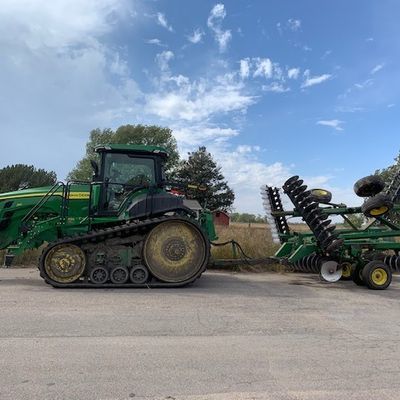Welcome back!
Did you know the Crane Trust collectively manages approximately 10,000 acres of land, surrounding almost 20 miles of the Platte River? To successfully do so, the Crane Trust utilizes a combination of management tools such as prescribed burning, rotational grazing, and disking. While I have spoken briefly about the application of disking in another blog post (All Life Starts with a Seed), this week I was able to get a closer look at how the Crane Trust utilizes disking and what it is able to accomplish for the conservation of the Platte River!
While the Crane Trust’s mission of habitat conservation spans across a variety of wildlife and vegetation species, Whooping Cranes and other migratory species, such as the Least Tern and Piping Plover, remain as core components in their habitat and river management decisions. These particular species select against rivers with deep channels, but prefer a shallow, braided river with bare sandbars and a view unobstructed by tall vegetation so they feel safe from predators while roosting overnight. Unfortunately, as you may have read in my last blog post (Understanding Water Underground!), large scale use of groundwater irrigation for agriculture and damming over time has led to a tremendous drop in surface water availability, which has historically contributed to the loss of over 1500 yards of open channel width in some areas of the Platte River. This decrease in a continuous flow of water throughout the Platte has allowed vegetation to take root along banks and channels. This not only obstructs the view for wildlife but can cause the river to lose even more water with the constant uptake by the vegetation.
This struggle of creating open habitat along an increasingly channelized and continually encroached upon river brings back the question, how does the Crane Trust and other similar organizations deal with this issue?
This week Tim Smith, Director of Land Management, and Jake Salter, Bison Coordinator, helped explain and demonstrate some of the tools used to help tackle this dilemma. Tim, Jake, and I traveled to the south bank of the river’s main channel, which was selected for disking because it is historically one of the widest segments of the river and an important crane roosting site. The opportunity to disk this portion of the river has been hindered in the past because of expansive woodland encroachment, of which the large trees were removed last year. This project was further made possible through funding provided by the Kiewit Foundation and the Nebraska Environmental Trust to purchase the two John Deere tractors (Pictured Below) powerful enough to get the job done.
Sandhill and Whooping Cranes could begin arriving along the Platte any day now as they migrate to their wintering grounds. Therefore, Time, Jake, and I had to observe the area in which we would be working on thoroughly for any signs of early arrivals roosting on the river. Once we confirmed that there were no roosting cranes on the river, Tim and Jake both hopped into the tractors equipped with large agricultural disks and began making several passes along a half-mile stretch of the river. The total area they worked on that day spanned across 20 acres, where they leveled and uprooted any vegetation that was in their path. Even while I observed from the other side of the river, I was shocked to see the size and strength of the machines and the smooth, sandy path they left behind.


Though disking is not the only management tool used to preserve historic characteristics of the braided river, such as allowing high river flows to move the sandbars in order for them not to revegetate, but it is also key management tactic that prepares the Platte River for the upcoming migratory visitors. These visitors not only depend on the area for foraging and roosting activities, but they also use them in order to fuel up and prepare for their journey to their final destination!
Throughout this fellowship I have worked hands-on with smaller equipment, but I had not had the opportunity to witness management on as large of a scale as the agricultural disc be utilized. It truly emphasizes the amount of effort and manpower needed to continuously work to keep this river functional, which is at the heart of the Crane Trust’s mission!
To learn more about disking and how it is being used along the Platte River, visit this link: https://linktr.ee/cranetrustdisking
Until next time!
Cheers,
Amanda Medaries

